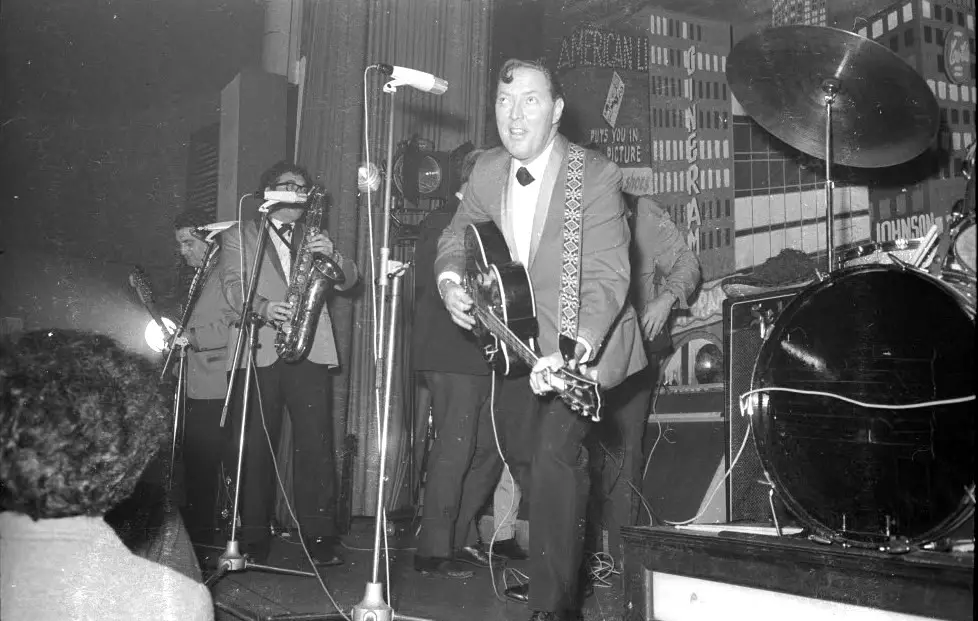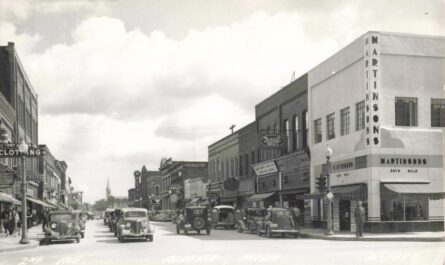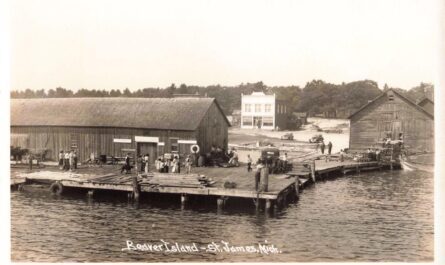Bill Haley helped launch rock and roll into mainstream music. His song Rock Around the Clock became a global hit, making him one of the first rock stars. Born on July 6, 1925, in Highland Park, Michigan, Haley grew up in a musical household. His parents encouraged his interest in music, setting the stage for his future career. Despite facing physical challenges from a young age, he developed a passion for performing. His early love for country and rhythm and blues shaped his signature sound.
Early Life and Musical Beginnings
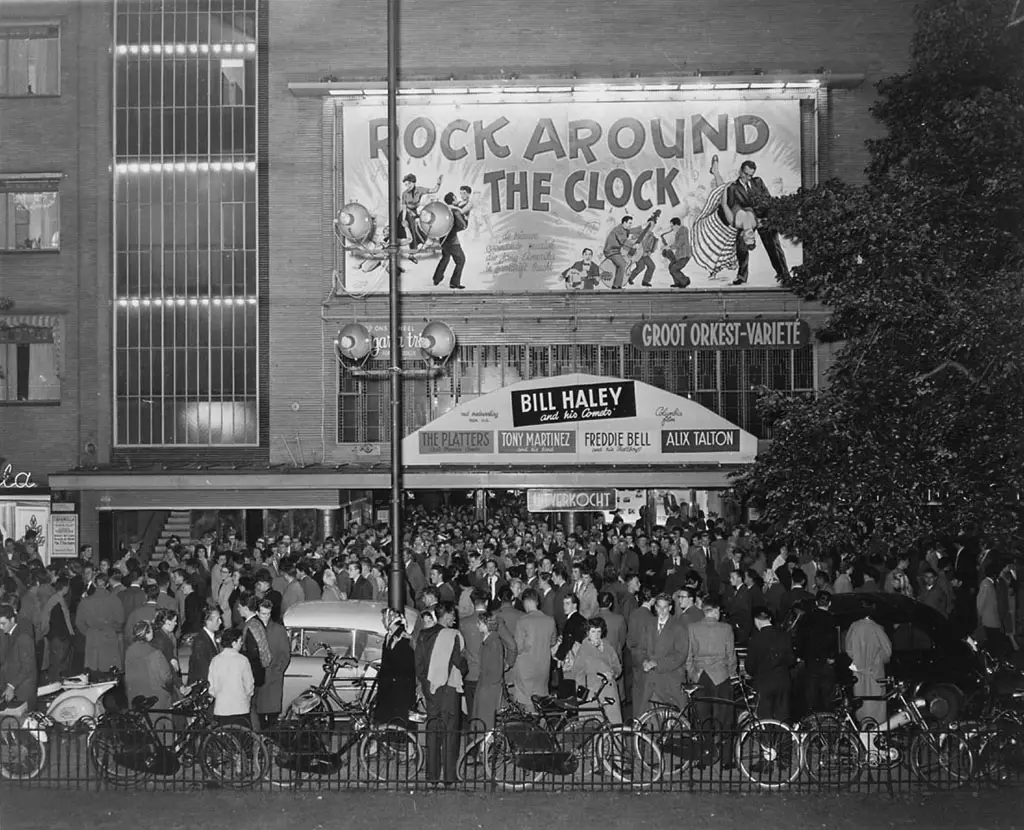
Foto Ben van Meerendonk, collectie IISG, Amsterdam – IISG, CC BY-SA 2.0 via Wikimedia Commons
Bill Haley’s father played banjo and mandolin, while his mother was a classically trained pianist. Their influence helped him develop an interest in music from an early age. At four years old, a mastoid operation left him blind in his left eye. This partial blindness made him self-conscious, and he often hid his eye behind a lock of hair, creating what would later become his signature look.
Haley received his first guitar at age 13. He quickly learned to play and started performing at local events. As a teenager, he joined various country and western bands, where he showcased his talent as a guitarist and yodeler. In 1945, he became a member of The Downhomers, a group that toured the Midwest and East Coast. His early years in country music exposed him to the evolving styles of rhythm and blues.
During the late 1940s, Haley worked as a radio DJ at WPWA in Chester, Pennsylvania. This job gave him access to a wide range of music, and he began experimenting with blending country sounds with the energy of R&B. His band, The Four Aces of Western Swing, later renamed The Saddlemen, reflected this fusion. By the early 1950s, Haley had started moving away from traditional country music, setting the stage for his transition into rock and roll.
Transition to Rock and Roll
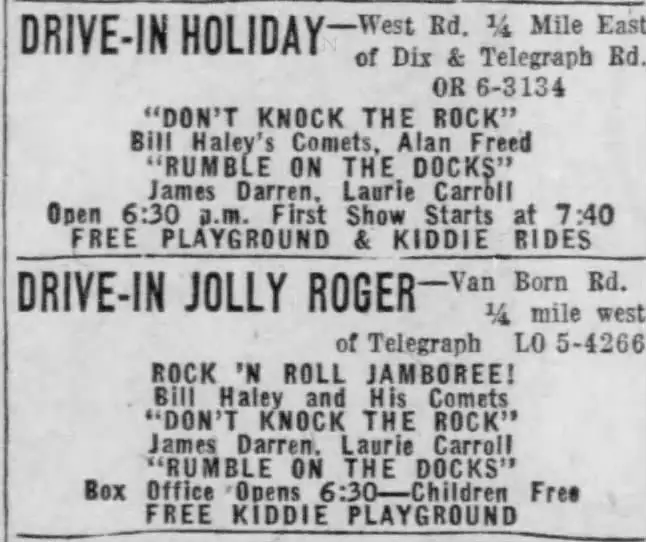
By the early 1950s, Bill Haley was looking for a new sound. His band, The Saddlemen, had started blending country music with the upbeat rhythms of rhythm and blues. This fusion created something new and energetic. In 1951, Haley recorded a cover of Rocket 88, a song originally by Jackie Brenston and Ike Turner. Many consider Rocket 88 one of the first rock and roll songs. Though it did not achieve major success, it marked Haley’s shift toward a new musical style.
In 1952, Haley and his band rebranded as Bill Haley & His Comets. The name reflected their fast-paced, high-energy music. In 1953, they released Crazy Man, Crazy, which became the first rock and roll song to chart on Billboard. The success of the song proved that this new style had an audience.
Rise to Fame with The Comets
In 1954, Bill Haley & His Comets recorded Rock Around the Clock. The song was initially overlooked, but everything changed in 1955 when it was featured in the film Blackboard Jungle. The movie’s use of the song helped push it to the top of the charts. By July 1955, Rock Around the Clock became the first rock and roll song to reach No. 1 on the Billboard Hot 100.
The success of Rock Around the Clock made Bill Haley a global star. He followed it with hits like Shake, Rattle and Roll and See You Later, Alligator. His music had a driving rhythm, catchy melodies, and a rebellious energy that appealed to young listeners. As rock and roll gained popularity, Haley became one of its most recognizable faces.
In 1957, Haley and The Comets toured internationally, performing in the UK, Australia, and Europe. Their concerts drew huge crowds, sometimes leading to frenzied reactions from fans. One famous event in London, later called the “Second Battle of Waterloo,” saw police struggling to control excited teenagers. Haley’s success abroad continued even as his popularity in the U.S. began to decline.
Subsequent Successes and Challenges

By the late 1950s, Bill Haley & His Comets were still producing hits, but the music scene was changing. A new wave of rock and roll artists, including Elvis Presley, Jerry Lee Lewis, and Buddy Holly, took the spotlight. These younger performers had a more rebellious image that appealed to teenage audiences. Compared to them, Haley, already in his 30s, seemed more like a polished performer than a rock icon.
Despite a decline in U.S. popularity, Haley remained a major star overseas. His tours in Latin America and Europe drew massive crowds. In Mexico, he recorded Spanish-language songs, further expanding his fan base. His influence on early rock musicians remained strong, even as he struggled to maintain his place in the American charts.
As the 1960s began, musical trends shifted toward new styles like British Invasion rock and psychedelic music. Haley’s rockabilly sound fell out of fashion. He continued performing, but his presence in the industry faded. Though his music was no longer topping the charts, his role in rock history remained undeniable.
Later Years and Legacy

In the 1970s, Bill Haley experienced a brief revival. The use of Rock Around the Clock in the 1973 movie American Graffiti introduced his music to a new generation. The song also became the opening theme for the TV show Happy Days, further cementing its place in pop culture. Haley and The Comets continued touring, but his struggles with alcoholism and declining health took a toll.
In 1980, Haley gave his final performances in South Africa. Shortly after, he withdrew from the public eye. On February 9, 1981, he died of a heart attack at his home in Harlingen, Texas. He was 55 years old.
Though his career was overshadowed by later rock legends, Bill Haley’s influence on rock and roll remains significant. In 1987, he was inducted into the Rock and Roll Hall of Fame. His music laid the foundation for the genre, and Rock Around the Clock remains one of the most recognized songs in rock history.
A Final Note
Bill Haley played a critical role in the birth of rock and roll. His fusion of country, rhythm and blues, and swing helped shape a sound that would define a generation. Rock Around the Clock was not just a hit song—it was a turning point in music history. It introduced millions to a new style and set the stage for the rock explosion that followed.
While younger artists eventually took the spotlight, Haley’s contributions should not be overlooked. His music inspired early rock pioneers and helped establish the genre’s commercial success. His influence extended beyond the U.S., reaching audiences worldwide.
Today, Bill Haley’s legacy lives on. His songs continue to appear in movies, television, and commercials, keeping his sound alive for new generations. His work remains a reminder of rock and roll’s early days and the excitement of a musical revolution. As one of the genre’s first stars, he helped shape popular music and left a lasting impact that continued decades after his passing.
Sources
- “Bill Haley.” Wikipedia, Wikimedia Foundation, last edited 3 Feb. 2025, en.wikipedia.org/wiki/Bill_Haley.
- “Bill Haley & His Comets Discography.” Wikipedia, Wikimedia Foundation, last edited 3 Feb. 2025, en.wikipedia.org/wiki/Bill_Haley_%26_His_Comets_discography.
- “Bill Haley.” Encyclopædia Britannica, Encyclopædia Britannica, Inc., last updated 10 Jan. 2025, www.britannica.com/biography/Bill-Haley.
- “Bill Haley: The Father of Rock ‘n’ Roll.” BillHaley.com, Bill Haley Estate, billhaley.com/.
- “Bill Haley – Biography.” IMDb, IMDb.com, www.imdb.com/name/nm0006426/bio/.
- “Bill Haley And His Comets.” Discogs, Zink Media, Inc., www.discogs.com/artist/282897-Bill-Haley-And-His-Comets.
- “Bill Haley.” Discogs, Zink Media, Inc., www.discogs.com/artist/135191-Bill-Haley.
- “Bill Haley Discography – USA.” 45cat, www.45cat.com/artist/bill-haley.
- “YouTube Gold: Rock Around The Clock.” Duke Basketball Report, 15 Dec. 2024, www.dukebasketballreport.com/2024/12/15/24321545/youtube-rock-around-the-clock-bill-haley-and-his-comets-elvis-presley-chuck-berry-little-richard.
- “Los impulsores del rock and roll lograron ponerlo de moda pero acabaron mal.” El País, 15 Nov. 2024, elpais.com/television/2024-11-15/los-impulsores-del-rock-and-roll-lograron-ponerlo-de-moda-pero-acabaron-mal.html.
